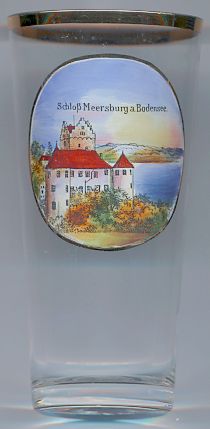

|
| DEUTSCHLAND | GERMANY |
| Bundesland: Baden-Württemberg | |
| Regierungsbezirk: Tübingen | |
| Landkreis: Bodenseekreis |
 Meersburg is situated at an elevation of 444 m at the northern bank of Lake Constance.
Meersburg has a population of about 5,550 (2006).
Meersburg is situated at an elevation of 444 m at the northern bank of Lake Constance.
Meersburg has a population of about 5,550 (2006).
Meersburg castle was first mentioned as Merdesburch in a document of 1147. The old settlement began to develop beneath the castle. The 'Upper Town' received the privileges of a market town in 1233 and those of a town in 1299. When the city of Konstanz had converted to the Protestant faith, the Catholic bishops of Konstanz move their residence to Meersburg in 1526. After the Reichsdeputationshauptschluss of 1803, the secular powers of the bishops were abolished and their territories were incorporated into the margraviate (1806 grand duchy) of Baden. Meersburg remained the seat of the bishops until 1821 when the bishopric was abolished and was incorporated into the archdiocese of Freiburg.
 Meersburg castle [left] was first mentioned in AD 988 and probably goes back to a
Merowingian stronghold that protected a ferry that connected Upper Swabia with Konstanz. After the 11th century the castle came in possession
of the bishops of Konstanz who gave it as a fief to the counts of Rohrdorf-Messkirch. When the counts had become extinct in 1210,
the castle remained an immediate possession of the bishops. Konradin of Hohenstaufen, King of Sicily and last member of the Hohenstaufen dynasty,
spent his last years in the castle before he was beheaded as a traitor in Sicily. From 1526 until 1802 the castle was the residence of the
bishops of Konstanz. When the territory of the bishops was incorporated into the margraviate of Baden, the castle was used as a court of law,
a branch office of the court of law at Donaueschingen. In 1838 the Grand Duke sold off the castle. From 1841 onwards, the castle was home of
the German poet Annette von Droste-Hülshoff who spent part of her last eight years of her life here.
The castle has remained a private property until today.
Meersburg castle [left] was first mentioned in AD 988 and probably goes back to a
Merowingian stronghold that protected a ferry that connected Upper Swabia with Konstanz. After the 11th century the castle came in possession
of the bishops of Konstanz who gave it as a fief to the counts of Rohrdorf-Messkirch. When the counts had become extinct in 1210,
the castle remained an immediate possession of the bishops. Konradin of Hohenstaufen, King of Sicily and last member of the Hohenstaufen dynasty,
spent his last years in the castle before he was beheaded as a traitor in Sicily. From 1526 until 1802 the castle was the residence of the
bishops of Konstanz. When the territory of the bishops was incorporated into the margraviate of Baden, the castle was used as a court of law,
a branch office of the court of law at Donaueschingen. In 1838 the Grand Duke sold off the castle. From 1841 onwards, the castle was home of
the German poet Annette von Droste-Hülshoff who spent part of her last eight years of her life here.
The castle has remained a private property until today.
![[scale]](lineal.jpg)